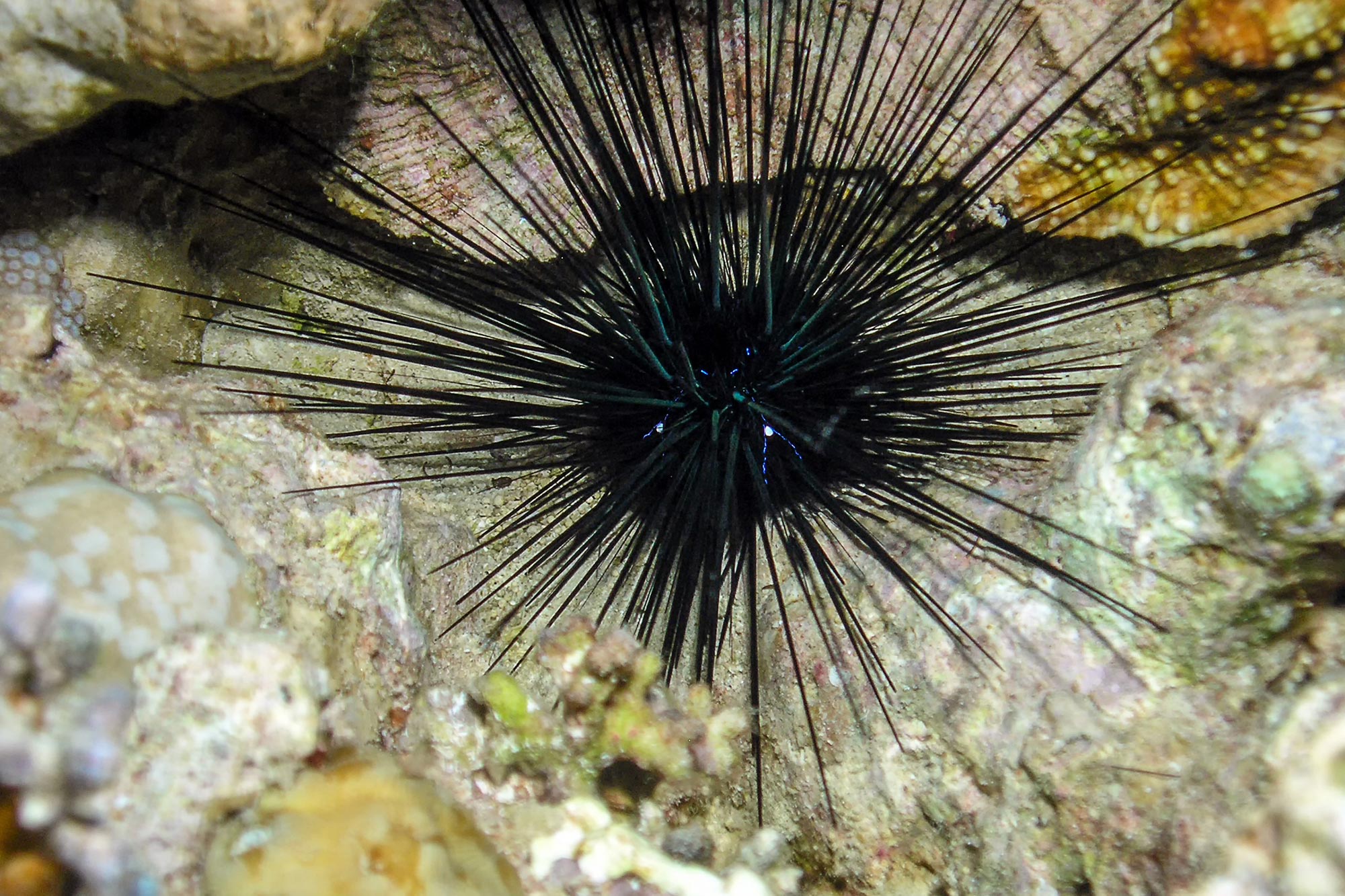
Um organismo unicelular, escuticociliado, foi identificado como a causa da morte em massa de ouriços-do-mar de espinhos longos em 2022 no Caribe e na costa leste da Flórida. Esses ouriços são essenciais para a saúde dos recifes de corais, e a descoberta levanta questões sobre a presença de ciliados, suas condições de crescimento e seu potencial impacto sobre outras espécies. Fotografia do longo e espinhoso ouriço-do-mar (Diadema antillarum).
A morte em massa do ouriço-do-mar de espinha longa – uma perda que ameaça a saúde dos recifes de corais do Caribe à costa leste da Flórida – foi causada por um organismo unicelular chamado ciliado.
A caçada por um assassino terminou em 2022, que eliminou ouriços-do-mar de espinhos longos no Caribe e ao longo da costa leste da Flórida. Uma equipe de pesquisadores organizada por Mia Breitbart, ilustre professora da Faculdade de Ciências Marinhas da Universidade do Sul da Flórida, identificou um organismo unicelular chamado ciliar como a causa da morte em massa de um animal marinho vital para a saúde dos recifes de corais.
Suas descobertas foram publicadas em 19 de abril na revista Nature
Ciliate culture viewed under the microscope. Credit: Mya Breitbart USF College of Marine Science
“We’re beyond thrilled to get to the bottom of the 2022 mystery and a bit stunned we did it so quickly,” said Breitbart, senior author on the Science Advances study and an expert in marine genomics. “We had a great team in place and the tools needed to do the ocean science equivalent of a forensic investigation.”
Ciliates are microscopic organisms covered in hair-like structures called cilia that help them move and eat. They are found almost anywhere there is water and most are not disease-causing agents. However, this specific species of ciliate – called a scuticociliate – has been implicated in die-offs of other marine species, such as sharks, in the past.

Photo compilation showing the same sea urchin before and after infection with the ciliate in the USF aquarium research facility. Credit: Makenzie Kerr USF College of Marine Science
Examining urchins collected from 23 sites in the Caribbean, the research team used a series of techniques to confirm the source of the die-off event.
After identifying the ciliate in every affected urchin specimen using genomic techniques, the team grew ciliates in the lab and performed infection experiments at the USF College of Marine Science. When the pathogen was introduced to otherwise healthy urchins in an aquarium tank, the urchins died within a few days – replicating what was taking place in the ocean and confirming the ciliate as the disease source.

DaSc-affected sea urchin, Aruba, August 2022. Credit: Ian Hewson Cornell University
“We’re excited to share this information with everyone, from reef managers to additional scientists so we can explore it further and try to stop its spread,” Breitbart said.

Mya Breitbart (USF) viewing the ciliate culture by microscopy. Credit: Makenzie Kerr USF College of Marine Science
The long-spined sea urchins inhabit shallow tropical waters and feed on algae that would otherwise destroy a reef. They began to lose their spines within days of contracting an unknown disease and died in droves starting in January 2022.
A similar die-off event took place in the early 1980s, which wiped out 98 percent of the long-spined sea urchin population. The culprit of that die-off remains a mystery.
Breitbart first got the call about the unfolding die-off at the end of March 2022. She immediately assembled a team consisting of Ian Hewson, lead author on the publication and a marine ecologist at Cornell University; Christina Kellogg, a microbiologist from the U.S. Geological Survey in St. Petersburg, Fla. who has worked extensively on coral reef diseases; and USF graduate student Isabella Ritchie.
“At the time, we didn’t know if this die-off was caused by pollution, stress, something else – we just didn’t know,” said Hewson, an expert in diseases that cause mass die-offs of sea stars, who flew from New York to the Caribbean Islands to observe the situation.
Even with the source of the mysterious die-off uncovered, questions still remain. For example:
- Is this ciliate new to the area, or was it there prior to the die-off?
- If it has been there, what environmental conditions favored its growth and why did it infect the urchins?
- Can it affect other species of urchins?
“Uma teoria que temos é que o ciliado cresceu bem sob as condições de alta produtividade observadas no Caribe quando começou a desaparecer”, disse Kellogg. “Também estamos curiosos sobre o fato de que há alguma sobreposição em algumas das áreas geográficas onde ocorreu essa extinção e onde os recifes de coral estão diminuindo devido à doença de perda de tecido de coral pedregoso”.
Referência: “Agente Scuticocylate Causes Mass Mortality of Diadema Antillarum in the Caribbean Sea” Por Ian Hewson, Isabella T Ritchie, James S Evans, Ashley Alterra, Donald Berenger, Irene Bowman, Marilyn Brandt, Kayla A. Budd e Rolio A. Camacho, Thomas O. Cornwell, Peter D. Kimani A. Kitson-Walters, Patricia Kramer, Judith C.Lang, Harilaos Lessios, Lauren Liddy, David Marancik, Stephen Nimrod, Joshua T. Patterson, Marit Pistor, Isabel C. Romero, Rita Sellares-Blasco, Moriah LB Sevier, William Sharp, Matthew Souza, Andrina Valdez-Trinidad, Maren van der Laan, Brian Villanova-Cuevas, Maria Villalpando, Sarah de Von Huene, Matthew Warham, Tom Weyers, Stacy M. Yanong, Soumira Zambrano, Alise Zimmerman, Mia Breitbart 19 de abril de 2023 Disponível aqui. Avanços da ciência.
DOI: 10.1126/sciadv.adg3200
A pesquisa foi financiada pela National Science Foundation, Atkinson Rapid Response Center for Sustainable Futures, AGGRA, National Oceanic and Atmospheric Administration, National Fish and Wildlife Foundation, Florida Keys Marine Preserve e Florida Fish and Wildlife Commission.

“Aficionado por música. Jogador. Praticante de álcool. Leitor profissional. Estudioso da web.”


